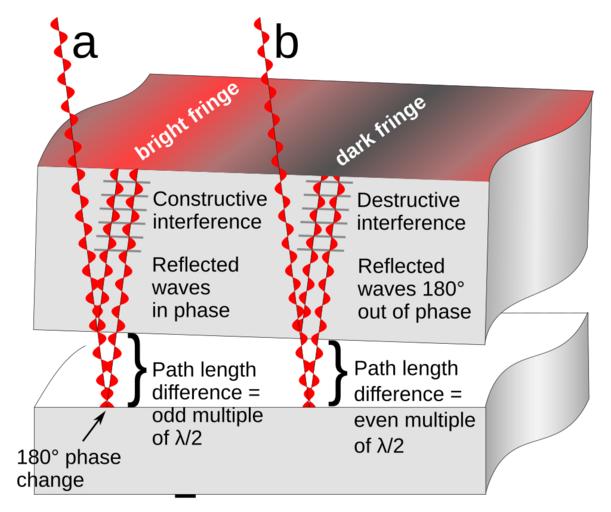MAKE A MEME
View Large Image

| View Original: | Optical flat interference.svg (1337x1115) | |||
| Download: | Original | Medium | Small | Thumb |
| Courtesy of: | commons.wikimedia.org | More Like This | ||
| Keywords: Optical flat interference.svg interference fringes are created by an optical flat The upper object is a section of a glass optical flat resting on another flat reflective surface Light rays red from a monochromatic light source pass through the flat and reflect from both the bottom surface of the glass and the surface it is resting on Since there is a tiny gap between the two surfaces the ray reflecting off the bottom surface travels a greater distance than the top ray It also experiences a 180° phase change at the reflection from the bottom plate the reflection from the top plate causes no phase change The parallel rays superpose At locations a where the extra distance travelled by the 2nd ray twice the width of the gap is equal to an odd multiple of a half-wavelength λ/2 of the light the two reflected waves will be in phase and will add reinforcing each other resulting in a bright reflected ray This is called constructive interference At other locations b the path difference between the rays is equal to an even multiple of λ/2 so the reflected waves are 180° out of phase They subtract canceling each other out resulting in little or no reflected light This is called destructive interference When the two surfaces are not parallel as in the diagram this results in a pattern of alternating bright and dark bands visible on the surface called interference fringes Two adjacent interference fringes represent a difference in height of the surface of one-half wavelength of the light used so interference patterns can be used to measure the flatness of surfaces to millionths of an inch In this diagram the width of the gap and the wavelength of the light waves is greatly exaggerated; light has wavelengths around 10<sup>-7</sup> meter 2012-03-03 own Chetvorno cc-zero Interference English text | ||||